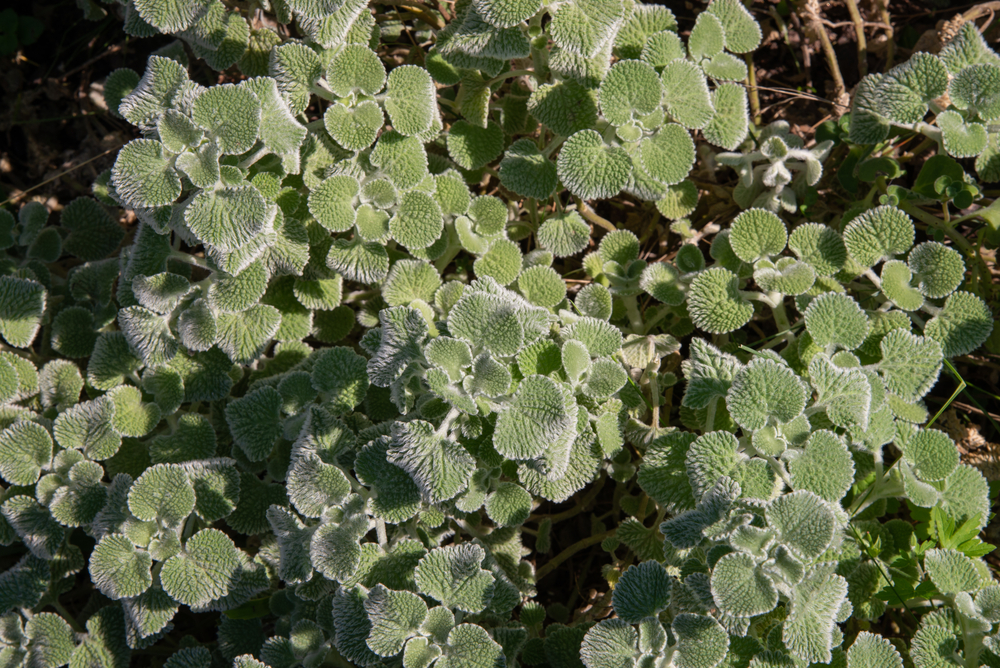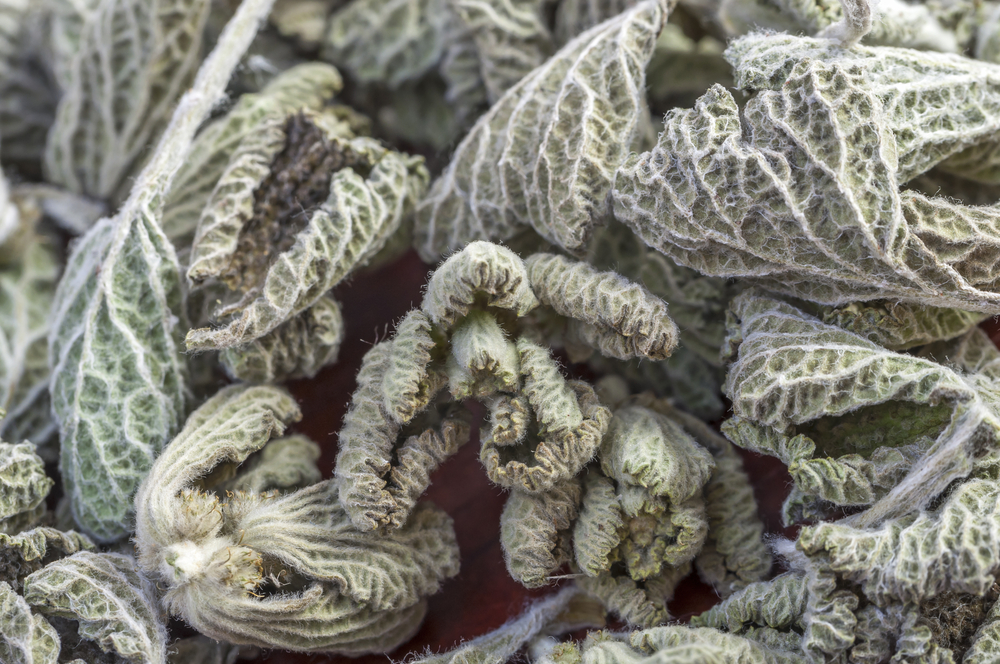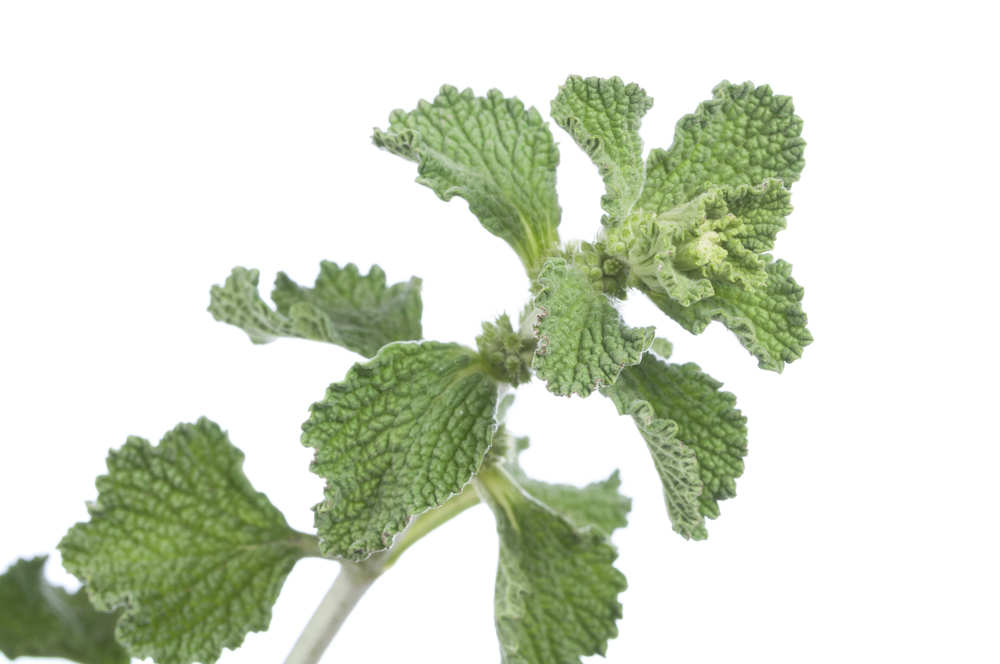White Horehound (Marrubium vulgare), also known as Common Horehound, is indigenous to the United Kingdom but it’s also found in Canada, throughout Europe, the US (United States), Australia, Southern Africa, and Western Asia.
Furthermore, there’s a reason so many people are interested in the Horehound Tea benefits that it has to offer. This hardy perennial – a member of the mint family – grows both wild and in cultivation, making it a hardy plant to make into tea.
The green, wrinkled leaves covered by white hairs are the most potent part of the plant in terms of health-giving properties. The tiny white flowers that cluster around the top of the stems in June and August also offer benefits but to a lesser degree.
The active ingredients in the leaves are a range of vitamins and minerals (iron, potassium, volatile oil, and vitamins A, B-complex, C, and E) and – most importantly – Diterpene lactone marrubium or bitter marrubium.
The leaves and flowers of the plant have been used for medicinal purposes for centuries and, along with many other natural products and remedies, are now enjoying a resurgence in popularity.

Traditional and Historic Uses
The earliest records of the use of this plant come from Egypt and ancient Rome. Egyptian priests believed that the plant was capable of fending off disease-causing spells, and it was also used to counteract poisoning.
The plant was also used for patients with respiratory problems. The ancient Romans used it as snake bite anti-venom and as a poison antidote. Some records show that the most common applications were for colds and coughs and as an antiseptic.
Native American tribes in the United States used it for centuries. In addition to chest problems, they used it to treat skin conditions, flush out the kidneys, and treat diarrhea, low blood pressure, and stomach aches.
Pregnant women were also given the herb as a pre-delivery aid. These tribes made ointments, poultices, and infusions from the herb.
In Britain in the 1500 and the 1600s several respected and pioneering doctors and herbalists wrote about this herb and its health benefits, particularly for those with chronic or acute respiratory conditions.
The first settlers in Australia used it, as did doctors in the United States in the 1700 and 1800s. While the settlers in America still administered the herb for lung conditions, they also began to use it for menstrual problems.
Today, it continues to be used in cough syrups, throat lozenges, and teas.
Benefits of Horehound Tea
The reputation of the white horehound variety of flowers and leaves as a health-giving herb is primarily based on historic references rather than scientific or clinical evidence.
As with most claims of health benefits, it’s always important to seek the medical advice of a health care professional and ensure that the use of horehound tea will give you the health benefits you seek.
Anecdotal and Traditional Benefits
The following list outlines the health benefits that have been attributed to this plant over the centuries:
- Acts as a decongestant by thinning and loosening phlegm in the lungs
- It has anti-inflammatory properties that soothe the throat and lungs
- Aids and boosts digestion and prevents indigestion and acid reflux
- Promotes the healthy production of bile and other fluids necessary in the digestive tract, which in turn reduces abdominal bloating and gas
- Eases uterine and digestive system cramps
- It has diuretic properties, so it helps to counteract water retention
- Aids in the removal of some intestinal worms
- It has antiseptic properties, so it can be used as a disinfectant for minor wounds
- Lowers blood sugar and cholesterol levels
According to Drugs.com:
“Preparations of Horehound are still largely used as expectorants, throat lozenges and tonics [and] may, indeed, be considered one of the most popular herbal remedies”
Preparations incorporating this herb include syrup for administration to children for colds, coughs, and upset stomachs. This source also states that Horehound tea is most effective against the common cold or cough.

Horehound Tea Benefits Under Investigation and/or Supported by Clinical Evidence:
More popular online sources such as WebMD point out that while there is some – including early – clinical evidence to support a range of health benefits from horehound tea and white horehound tea.
But there is insufficient evidence at this stage, and further and ongoing scientific studies are required.
The health benefits they list include lowering blood pressure, decreasing indigestion, and supporting the common cold symptoms such as cough and colds.
WebMD takes a more detailed and rigorous approach in discussing Horehound and its global status in terms of research and more mainstream medical acceptance.
They point out that, “Despite recommendations and assertions of beneficial usage over many centuries, the use of it has surprisingly little support in clinical research and medical studies.”
This source also notes that there are contradictions. For instance, the FDA ruled in 1989 that the herb is not an effective expectorant.
However, it is still used in some cough suppressants sold in the US. Findings and rulings in Germany didn’t contradict the FDA findings about respiratory benefits.
They did, though, indicate that it is effective in terms of indigestion and appetite loss as a digestive juice and bile stimulant. Significantly, German researchers also found no negative drug interactions, contraindications, or side effects.
On a more positive note, early findings in several studies and trials indicate that the white variety does warrant its centuries-old reputation.
The evidence is not overwhelming, but it is promising. At this stage, studies show that this plant lowers blood pressure and blood sugar levels and possesses both pain-relieving and antibacterial properties.
Studies in Italy and Brazil show that it has both pain-reducing and expectorant properties and antioxidant benefits.

How to make Horehound Tea
There seems little doubt that it offers a great deal in terms of health-giving or at least health-promoting properties. One of the easiest and most effective ways to benefit from this plant is by making tea from either fresh or dried leaves or flowers.
Making the tea is simple!
- Place 1 tablespoon of dried, fresh leaves or flowers for each cup in a pot or container (preferably not a plastic or metal one as they can taint the tea)
- Pour boiling water over the leaves or flowers
- Cover the container so that the essential oils released by the water don’t escape with the steam
- Leave the tea to steep or draw for at least 5 minutes. If you want stronger tea it will have to steep for longer
- Pour the tea through a strainer to remove any plant matter.
As with most other teas, it is a case of personal taste as to how strong the tea should be and whether a sweetener such as honey is needed. Lemon, aniseed, and peppermint can all be used to alter the taste. Milk should not be added, however.
Possible Side-Effects, Contraindications & Interactions
Just because this is a natural, plant-based product does not mean that it is 100% safe. There are certain individuals and circumstances where one should be particularly cautious.
Generally speaking, it should not be consumed or applied topically by:
- Women who are pregnant or breastfeeding as the effect of the plant on this group is not sufficiently well known
- Individuals who suffer from diabetes and are on medication for the condition as their blood sugar levels may drop too low
- Patients with low or high blood pressure or any kind of heart condition, including arrhythmia (irregular heartbeat) as the herb may exacerbate this
- Those who are on prescribed medications for water retention, sinus and/or lung congestion, expectorants, hormone therapy, statins or other medications to lower cholesterol, cold or flu preparations, or laxatives.
It should be kept in mind that ingesting too much of this plant can cause vomiting and/or diarrhea.
Conclusion
Despite some contradictory scientific or clinical studies, there is little doubt that horehound tea offers a range of valuable health-promoting benefits.
But, as with any other substance one consumes, caution must be used. It is crucial to consult your medical practitioner or health care professional before you start to explore the horehound tea benefits.
